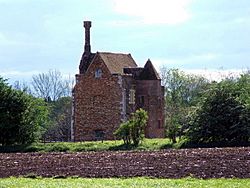Wardon Abbey facts for kids
 |
|
| Monastery information | |
|---|---|
| Full name | Abbey Church of the Blessed Virgin Mary, Old Warden |
| Other names | Warden Abbey |
| Order | Cistercian |
| Established | 1135 |
| Disestablished | 1537 |
| Site | |
| Location | Old Warden, Bedfordshire, England |
| Coordinates | 52°04′53″N 0°21′48″W / 52.081389°N 0.363333°W |
Wardon Abbey, also known as Warden Abbey, was an important old monastery in Bedfordshire, England. It was founded around 1135 by a group of monks from Rievaulx Abbey. These monks belonged to a special religious group called the Cistercians. Today, what's left of the abbey is a Grade I listed building, meaning it's a very important historical site.
Contents
History of Wardon Abbey
How Wardon Abbey Started
A wealthy man named Walter Espec helped start Wardon Abbey. He was also the founder of Rievaulx Abbey, the "mother house" from which the monks came. Walter Espec gave the monks some of his land, which was mostly unused wasteland. This kind of remote, quiet place was exactly what the Cistercian monks looked for when building their monasteries. The first leader of Wardon Abbey was Abbot Simon, who had been taught by Aelred, a famous abbot from Rievaulx.
Growth and Success
Wardon Abbey quickly became successful. By 1150, it was strong enough to start its own "daughter house," Sibton Abbey, in Suffolk. The nearby village of Old Warden even grew because of the abbey's presence and protection.
The Cistercian monks at Wardon Abbey became very wealthy. This allowed them to rebuild the abbey in a grand way in the early 1300s. The new buildings had amazing tiled floors with complex patterns, almost like a mosaic. The carved details were covered in so much gold that even fragments found in 1848 still looked bright!
By 1252, the monks had a lot of land for farming. They had nineteen "granges," which were like farm outposts managed by the abbey.
The Famous Warden Pear
The orchards at Wardon Abbey were famous for growing a special type of pear called the Warden pear. This pear was considered the best English pear. It was so well-known that a pie made from these pears was called a "wardon pie." Even William Shakespeare mentioned them in his play The Winter's Tale! There's even an old recipe for "Quyncis or Wardouns in past" (quinces or wardon pears in pastry) from a 15th-century cookbook.
Decline and Dissolution
The late 1300s were a difficult time for Wardon Abbey. After the Black Death (a terrible plague), the abbey faced challenges and began to decline.
In 1537, King Henry VIII ordered the closure of all monasteries in England, including Wardon Abbey. The king then sold the abbey's estate for £389 16s 6d. The new owner tore down most of the abbey buildings in 1552 to sell the materials. He then built a new red brick house called Warden Abbey House.
Later, in 1790, most of this Tudor house was also pulled down by its owners, the Whitbread family. Only a small part, the north-east wing, still stands today. In 1974, the Landmark Trust, a charity that saves historic buildings, rescued the remaining part of the house. They fixed it up, and now it can be rented for holidays, allowing people to stay in a piece of history!
Burials at Wardon Abbey
Some notable people were buried at Wardon Abbey:
- Anne Woodville
- George Grey, 2nd Earl of Kent
Gallery of Tiling from Warden Abbey
The beautiful tiles from Wardon Abbey are now on display at Bedford Museum.






